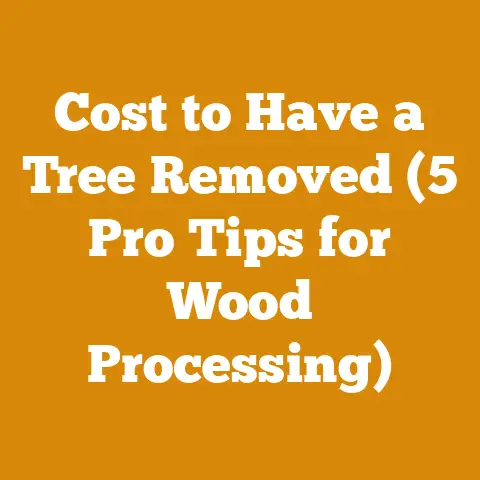Fertilizer Spikes for Pine Trees: Boost Growth (Expert Woodcare Tips)
The scent of pine needles, the crackle of a campfire, the rhythmic swing of an axe – these are the sounds and smells of my childhood. Growing up in the foothills of the Adirondacks, wood was more than just fuel; it was life. My grandfather, a seasoned logger, taught me everything I know, from identifying different tree species to splitting wood with a single, well-aimed blow. He always said, “A healthy tree is a happy tree, and a happy tree gives the best wood.” Now, as the years have passed and the forests have evolved, so too has our understanding of how to care for them. Today, I want to share my knowledge and explore the use of fertilizer spikes for pine trees, a topic that blends traditional wisdom with modern woodcare practices. Let’s delve into how these spikes can boost growth, improve wood quality, and ensure the longevity of these majestic trees.
Fertilizer Spikes for Pine Trees: Boost Growth (Expert Woodcare Tips)
The global wood processing, logging, and firewood industry is a significant economic driver, estimated to generate billions of dollars annually. However, sustainable forest management practices are becoming increasingly crucial to ensure the long-term health of our forests. According to the Food and Agriculture Organization (FAO), approximately 10 million hectares of forest are lost each year due to deforestation. Practices like targeted fertilization, including the use of fertilizer spikes, can play a vital role in promoting healthy tree growth and reducing pressure on existing forests.
Understanding the Need for Pine Tree Fertilization
Pine trees, like all living organisms, require essential nutrients to thrive. While they often grow in nutrient-poor soils, particularly sandy or acidic ones, a lack of essential elements can lead to stunted growth, increased susceptibility to diseases and pests, and reduced wood quality. This is where fertilizer spikes come in.
What are Fertilizer Spikes?
Fertilizer spikes are solid, pre-measured doses of nutrients designed to be inserted directly into the soil around a tree’s root system. They offer a slow-release mechanism, providing a consistent supply of nutrients over an extended period. This method minimizes nutrient runoff and ensures that the tree receives the necessary elements directly at the root zone.
Why Use Fertilizer Spikes for Pine Trees?
- Targeted Nutrient Delivery: Spikes deliver nutrients directly to the root zone, minimizing waste and maximizing absorption.
- Slow-Release Formula: The slow-release mechanism provides a consistent supply of nutrients over several months, reducing the need for frequent applications.
- Ease of Use: Spikes are easy to install and require no mixing or special equipment.
- Reduced Environmental Impact: By minimizing runoff, spikes reduce the risk of water pollution.
- Improved Growth and Health: Proper fertilization can lead to increased growth rates, enhanced resistance to diseases, and improved overall tree health.
Choosing the Right Fertilizer Spikes for Your Pine Trees
Selecting the appropriate fertilizer spikes is crucial for achieving optimal results. Consider the following factors:
Nutrient Ratio (N-P-K)
The nutrient ratio, represented as N-P-K (Nitrogen, Phosphorus, Potassium), indicates the percentage of each element in the fertilizer.
- Nitrogen (N): Promotes foliage growth and overall greenness.
- Phosphorus (P): Supports root development and flowering/cone production.
- Potassium (K): Enhances disease resistance and overall plant vigor.
For pine trees, a balanced N-P-K ratio is generally recommended, such as 10-10-10 or 12-6-6. However, the specific needs of your trees may vary depending on the soil conditions and the tree’s age and health. Soil testing can provide valuable insights into nutrient deficiencies.
Tree Species and Age
Different pine species have varying nutrient requirements. For example, young, rapidly growing pines may benefit from a higher nitrogen content, while mature trees may require more phosphorus and potassium to support cone production and overall health.
Soil Conditions
Conducting a soil test is essential to determine the nutrient deficiencies in your soil. This will help you select fertilizer spikes with the appropriate nutrient ratio to address those deficiencies. You can purchase a soil testing kit online or through your local garden center, or send a sample to a professional soil testing laboratory.
Fertilizer Type
- Organic Fertilizer Spikes: Made from natural materials like bone meal, compost, and manure. They release nutrients slowly and improve soil structure.
- Synthetic Fertilizer Spikes: Contain manufactured chemicals and release nutrients more quickly. They are often more concentrated and may be more effective for addressing severe nutrient deficiencies.
I personally prefer organic fertilizer spikes whenever possible. While they may take longer to show results, they contribute to long-term soil health and are less likely to cause nutrient imbalances.
Step-by-Step Guide to Using Fertilizer Spikes for Pine Trees
Now, let’s get to the practical part. Here’s a detailed, step-by-step guide on how to use fertilizer spikes for your pine trees:
1. Gather Your Supplies:
- Fertilizer spikes (appropriate for your tree species and soil conditions)
- Hammer or mallet
- Measuring tape
- Gloves
- Watering can or hose
2. Determine the Number of Spikes Needed:
The number of spikes required depends on the tree’s diameter at breast height (DBH). This is the diameter of the tree trunk measured approximately 4.5 feet (1.4 meters) above the ground. Refer to the fertilizer spike packaging for specific instructions on the number of spikes to use based on the tree’s DBH.
As a general guideline:
- Trees with a DBH of less than 2 inches (5 cm): 1-2 spikes
- Trees with a DBH of 2-4 inches (5-10 cm): 2-3 spikes
- Trees with a DBH of 4-6 inches (10-15 cm): 3-4 spikes
- Trees with a DBH of 6-8 inches (15-20 cm): 4-5 spikes
- Trees with a DBH of 8 inches (20 cm) or more: 5-6 spikes
3. Prepare the Soil:
Water the soil around the tree thoroughly before inserting the spikes. This will help soften the soil and make it easier to drive the spikes in.
4. Insert the Fertilizer Spikes:
- Using the measuring tape, determine the drip line of the tree. This is the imaginary line that extends from the outermost branches to the ground.
- Insert the spikes evenly spaced around the tree, just inside the drip line. This is where the majority of the tree’s feeder roots are located.
- Wearing gloves, hold the fertilizer spike at a 45-degree angle to the ground.
- Using the hammer or mallet, gently drive the spike into the soil until it is completely buried. Be careful not to break the spike.
- Repeat this process for all the remaining spikes, ensuring they are evenly spaced around the tree.
5. Water Thoroughly:
After inserting the spikes, water the soil around the tree again to help dissolve the fertilizer and allow it to reach the roots.
6. Monitor the Tree’s Response:
Observe the tree’s growth and health over the next several months. Look for signs of improved foliage growth, increased vigor, and enhanced resistance to diseases and pests.
Important Considerations and Best Practices
- Timing: The best time to apply fertilizer spikes is in the early spring or late fall, when the tree is actively growing but not stressed by extreme temperatures.
- Avoid Over-Fertilization: Applying too much fertilizer can be harmful to the tree. Always follow the instructions on the fertilizer spike packaging and avoid exceeding the recommended dosage.
- Soil pH: Pine trees generally prefer acidic soil (pH 5.0-6.0). If your soil is too alkaline, you can amend it with sulfur or peat moss to lower the pH.
- Mulching: Applying a layer of mulch around the base of the tree can help retain moisture, suppress weeds, and improve soil health.
- Watering: Pine trees need regular watering, especially during dry periods. Water deeply and infrequently, allowing the soil to dry out slightly between waterings.
- Pest and Disease Control: Regularly inspect your pine trees for signs of pests and diseases. Take appropriate measures to control infestations and prevent the spread of disease.
Case Study: Revitalizing a Stressed Eastern White Pine
I once worked with a homeowner who had a beautiful Eastern White Pine in their yard that was showing signs of decline. The needles were yellowing, the growth was stunted, and the tree was susceptible to various fungal diseases. A soil test revealed that the soil was deficient in nitrogen and phosphorus.
We decided to use organic fertilizer spikes with a 10-10-10 N-P-K ratio. We carefully followed the steps outlined above, inserting the spikes just inside the drip line of the tree. We also amended the soil with compost and applied a layer of pine straw mulch.
Over the next year, we observed a remarkable transformation. The needles regained their vibrant green color, the tree began to put on new growth, and its resistance to diseases improved significantly. The homeowner was thrilled with the results, and the Eastern White Pine is now thriving once again.
Troubleshooting Common Problems
- Spikes are difficult to insert: If the soil is compacted or rocky, it may be difficult to insert the spikes. Try pre-drilling a small hole with a garden auger or a sturdy screwdriver.
- Spikes are disappearing quickly: If the spikes are disappearing quickly, it may be due to excessive watering or leaching. Try using spikes with a slower-release formula or applying them in a more sheltered location.
- Tree is not responding to fertilization: If the tree is not responding to fertilization, it may be due to other factors, such as pest infestations, diseases, or improper watering. Consult with a certified arborist to diagnose the problem and recommend appropriate solutions.
Budgeting and Cost Considerations
The cost of fertilizer spikes varies depending on the brand, nutrient ratio, and quantity. Organic fertilizer spikes tend to be more expensive than synthetic ones. However, the long-term benefits of organic fertilization, such as improved soil health and reduced environmental impact, may outweigh the higher cost.
Here’s a general estimate of the cost of fertilizer spikes:
- Organic Fertilizer Spikes: $10-$20 per package (containing 4-6 spikes)
- Synthetic Fertilizer Spikes: $5-$15 per package (containing 4-6 spikes)
The total cost of fertilizing your pine trees will depend on the number of trees you need to fertilize and the number of spikes required per tree.
Sustainability and Environmental Impact
While fertilizer spikes can be beneficial for promoting tree growth and health, it’s important to consider their environmental impact. Synthetic fertilizers can contribute to water pollution and soil degradation if not used properly. Organic fertilizers are generally more environmentally friendly, as they are made from natural materials and improve soil structure.
Here are some tips for minimizing the environmental impact of fertilizer spikes:
- Choose organic fertilizer spikes whenever possible.
- Follow the instructions on the packaging carefully and avoid over-fertilization.
- Apply fertilizer spikes in a way that minimizes runoff and leaching.
- Consider using other sustainable practices, such as composting and mulching, to improve soil health.
The Future of Pine Tree Care: Innovations and Trends
The field of pine tree care is constantly evolving, with new innovations and trends emerging all the time. Here are a few to keep an eye on:
- Conduct a soil test to determine the nutrient deficiencies in your soil.
- Choose the appropriate fertilizer spikes for your tree species and soil conditions.
- Follow the step-by-step guide to insert the fertilizer spikes correctly.
- Monitor the tree’s response and adjust your fertilization strategy as needed.
- Consult with a certified arborist if you have any questions or concerns.
Here are some additional resources that you may find helpful:
- Local garden centers and nurseries: These businesses can provide advice on selecting the right fertilizer spikes and other tree care products.
- University extension services: These services offer educational materials and workshops on tree care and sustainable forestry practices.
- Professional arborists: Certified arborists can provide expert advice on tree health, fertilization, and pest and disease control.
- Online forums and communities: Connect with other tree enthusiasts and share your experiences and knowledge.
Key Concepts Explained
- Green Wood vs. Seasoned Wood: Green wood refers to freshly cut wood that has a high moisture content, typically above 30%. Seasoned wood, on the other hand, has been dried to a moisture content of 20% or less, making it ideal for burning as firewood.
- Types of Logging Tools: Logging tools include chainsaws, axes, wedges, felling levers, and log skidders. Chainsaws are used for felling trees and bucking logs, while axes are used for splitting wood and felling smaller trees. Wedges and felling levers are used to help direct the fall of a tree. Log skidders are used to transport logs from the forest to a landing area.
- Moisture Content Targets for Firewood: The ideal moisture content for firewood is 15-20%. This allows the wood to burn efficiently and produce maximum heat. You can measure the moisture content of firewood using a moisture meter.
Conclusion: Nurturing Our Pine Forests for Future Generations
Fertilizer spikes can be a valuable tool for boosting the growth and health of pine trees, but they are just one piece of the puzzle. Sustainable forest management practices, including proper watering, mulching, and pest and disease control, are essential for ensuring the long-term health of our forests. As stewards of the land, it is our responsibility to care for these majestic trees and ensure that they thrive for generations to come. The scent of pine, the warmth of a fire – these are legacies worth preserving, and I’m committed to doing my part. Now, go forth and nurture your pines!






